
As part of their Virtual Site Tours, they visit Boeing Auburn and learn all about Additive Manufacturing, with a segment on one of Boeing's two Thermwood LSAM 1020 systems starting at the 12:49 mark.
𝗩𝗶𝗱𝗲𝗼 𝗟𝗶𝗻𝗸 𝗛𝗲𝗿𝗲: https://bit.ly/3YX3tkc
Posted by Duane Marrett on Fri, Mar 17, 2023
Tags: Thermwood, Video, virtual tour, Thermwood LSAM, Boeing, LSAM 1020, Boeing Auburn, Discovery Education

Posted by Duane Marrett on Tue, Jan 04, 2022
Tags: Thermwood, Announcements, Local Motors, Thermwood LSAM, Patented, Boeing, Navair, Al Davis Torch, General Atomics
Thermwood routinely applies for patent protection on additive manufacturing technology it develops for its LSAM large format additive systems. During COVID, we received electronic copies of patents that were granted, however, the official hard copies were withheld.
A couple of days before Christmas 2021, we received a package containing the official hard copy of 32 additive manufacturing patents. This was certainly a one-day record for Thermwood and a welcome sight!
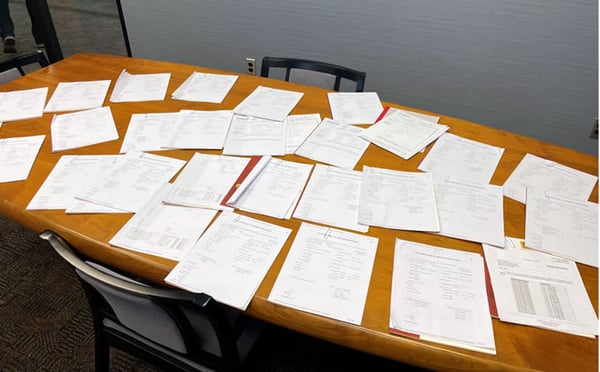
In addition to these latest patents, Thermwood already has a large portfolio of earlier issued patents covering the unique, large format (5x10 foot table and larger) 3D print technology it has developed. This LSAM technology is currently the most widely used large scale additive print technology operating in industry today. It’s used in a wide variety of industries including aerospace, transportation, heavy equipment, foundry and large decorative structures. It is being used to produce a diversity of products including aerospace patterns, molds and tooling, heavy equipment foundry patterns, bus chassis, large valve body foundry patterns and trim tooling. It was even used to print the tallest 3D printed structure in the world, the 92 foot tall Al Davis Memorial Torch at Allegiant stadium in Las Vegas.
Thermwood offers this unique patented technology on a wide variety of equipment, the largest, most diverse product offering of its kind available today. It includes a broad selection of machines, including single and dual gantry, fixed and moving table configurations, with both print-only and print-and-trim systems, from 5 by 10 foot to 20 by 60 foot print envelopes. We are working on even larger machines but that’s for another day.
The primary focus of the patented LSAM technology is to reliably and repeatedly produce the highest quality, best fused, most homogeneous printed structures possible from a variety of reinforced thermoplastic polymer composites including those intended to operate at elevated temperatures. Although it is nice to have been granted these patents, it is even nicer to finally have the official hard copies in hand.
Posted by Duane Marrett on Thu, Aug 19, 2021
Tags: Thermwood, Announcements, Large Scale, Thermwood LSAM, Boeing, Book, Additive Manufacturing Guide

This 315 page book, currently available as either an eBook or paperback hardcopy, is intended to help non-technical managers understand the basics behind a new technology that is revolutionizing production of large composite molds, tools and other industrial and commercial products.
Where to Purchase
This book is currently available from Amazon either as an electronic file or as a printed hardcopy.
Who This Book is For
If you are a manager in an industrial company who might benefit from large scale additive technology, or, if your company is actively exploring this technology, this book will give you the background you need to participate and make better decisions. It will also help you cut through the confusion and crosstalk that often accompanies a new technology like this.
More InfoIndustrial additive manufacturing is currently being used successfully every day to produce some of the largest composite parts ever made. These include large aerospace molds and tools, foundry patterns for various industries, chassis for electric busses and what is likely the tallest 3D printed structure ever made. Although the process results in substantial savings and dramatically reduces lead time, much of industry today still doesn’t understand or trust it.
In this book, the author, who was instrumental in developing the technology actually being used in industry today, explains in everyday, no nonsense language what it is, how it works, what actually works, what doesn’t and why. He provides a guide for non-technical managers to help them understand the basics so they can evaluate how this new technology might impact their company.
He explores all aspects of this process in clear, easy to understand language including the print process, polymers, software, trimming, cost savings, time savings, computer simulation and the practical, real world, aspects of getting into large scale additive. He includes sometimes humorous vignettes about surprises, missteps and stumbles during initial technology development and how they were handled.
About the Author
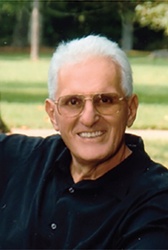 The author, Ken Susnjara, is the founder, Chairman and CEO of Thermwood Corporation, the leading supplier of large scale additive systems for the production of thermoplastic composites. With almost 100 patents to his name, he was instrumental in the development of the underlying technology behind the most successful large scale additive systems today.
The author, Ken Susnjara, is the founder, Chairman and CEO of Thermwood Corporation, the leading supplier of large scale additive systems for the production of thermoplastic composites. With almost 100 patents to his name, he was instrumental in the development of the underlying technology behind the most successful large scale additive systems today.
Posted by Duane Marrett on Wed, Jun 30, 2021
Tags: Thermwood, Announcements, Large Scale, Thermwood LSAM, Navy, Composite Tooling, Boeing, Navair, Collaboration, Fleet Readiness Center
Thermwood was a key development partner in a Navy ManTech funded program issued to Boeing Research and Technology. The ManTech program was managed by Advanced Technology International (ATI) for the Office of Naval Research (ONR) with funding provided from the Naval Air Systems Command (NAVAIR) Aircraft Equipment Reliability & Maintainability Improvement Program (AERMIP). Fleet Readiness Center East (FRCE) was a key technical contributor for the low cost composite cure tooling technology development.
Thermwood’s Large Scale Additive Manufacturing (LSAM) machine was selected as the Large Format Additive Manufacturing (LFAM) machine to conduct the technology development. Several unique equipment features of the LSAM machine drove the selection. The high temperature autoclave cure tooling operating environment of 355 degree Fahrenheit and 85 psi provides a challenge for polymer based tool material. Additional composite cure tooling requirements for vacuum integrity and dimensional stability were validated during the development. Neil Graf Office of Naval Research, noted “Composite manufacturing is a strategic technology for future platforms and development of more cost effective tooling solutions would significantly benefit the implementation.”
FRCE provided a high contour mold line surface to Boeing for generating the composite cure tool. The mold line shape was very aggressive and would stretch the large format additive manufacturing technology processes capability. The spherically shaped portion of the mold line offered the largest challenge, as the unsupported 3D printed angle limitation of approximately 45 degrees provides an interesting obstacle to overcome for the spherical mold line section of the tool. Boeing rotated the 3D print plane 35 degrees to avoid encroachment of the build angle limitation.
The new innovative build plane approach eliminated the requirement for temporary support material for the aggressive mold line shape. The new build angle would test the LSAM machine limits in an area never explored previously. TechmerPM PESU CF 1810 high temperature print material was used for the composite cure tool. High temperature materials present additional challenges during print over low temperature materials such as ABS CF. Two interim support features were added to compensate for the center of gravity shift of the print. The LSAM machine performed flawlessly during the composite cure tool print. The tool was printed in 7 hours and 26 minutes using 610 lbs of material.
The composite cure tool was machined in 53 hours using the LSAM gantry router machine. The tool datum features, and removal of interim members, were machined prior to removal from the bead-board. The Thermwood LSAM machine offers the ability to machine and 3D print on a single platform. The composite cure tool mold line part surface achieved at surface profile tolerance of .020” (+/-.010”).
The Boeing Research and Technology (BR&T) laboratory performed functional testing on the LFAM composite cure tool to ensure vacuum integrity and dimensional stability requirements were reached. The LFAM tool performed as expected and achieved all requirements. Several composite parts were fabricated from the tool. The tool durability was assessed during the multiple autoclave cure cycles and fabricated (3) composite parts. The tool maintained dimensional stability and vacuum integrity throughout the functional testing and composite part manufacturing.
The composite cure tool was printed and NC machined on Thermwood’s Large Scale Additive Manufacturing (LSAM) 1020 machine. The LFAM technology cost savings was estimated at 50% compared to traditional tool fabrication methods, and reduced tool fabrication lead-time by 65%. The cost savings and tool fabrication cycle time reduction could provide enormous benefit to any organizations performing low volume or custom composite part fabrication and repair.
Nondestructive Inspection (NDI) was performed on the composite parts fabricated on LSAM tools. The NDI results did not indicate any porosity. Due to the complex shape of the composite demonstration part several NDI process were employed. X-ray and C-Scan results did not reveal any delaminations or defects.
The program benefited from a cooperative effort among several contributors to achieve success. The partnership between industrial technology leaders, Boeing and Thermwood coupled with the Office of Naval Research’s drive to transition technology, led to the successful program. “Collaborations such as this help expand the scope of capabilities of emerging large scale additive technology by addressing real world challenges that would be difficult for any single entity to define and address by itself. We look forward to new challenges moving forward”, says Thermwood CEO, Ken Susnjara.
Additional development is key to expand LFAM composite cure tooling implementation. Boeing Associate Technical Fellow Michael Matlack commented “The program provided significant results in validating additive manufacturing as a viable method of producing lower cost, capable tooling with substantial time savings over traditional methods.”
Posted by Duane Marrett on Thu, Aug 08, 2019
Tags: Thermwood, Announcements, Additive, LSAM, Thermwood LSAM, Additive Manufacturing, Boeing, Air Force, Air Force Research Laboratory
The United States Air Force Research Laboratory (AFRL) Manufacturing and Industrial Technology Division (ManTech) is interested in large scale polymer-based additively manufactured (AM) composite cure tooling. Boeing submitted an idea to ManTech’s Open BAA to evaluate the current state of additive manufacturing technology with respect to the fabrication of low cost autoclave capable tools for the production of composite aerospace components. The initial demo tool is for an AFRL concept aircraft fuselage skin (Figure 1). Boeing contracted Thermwood to demonstrate capability of their Large Scale Additive Manufacturing (LSAM) machine.
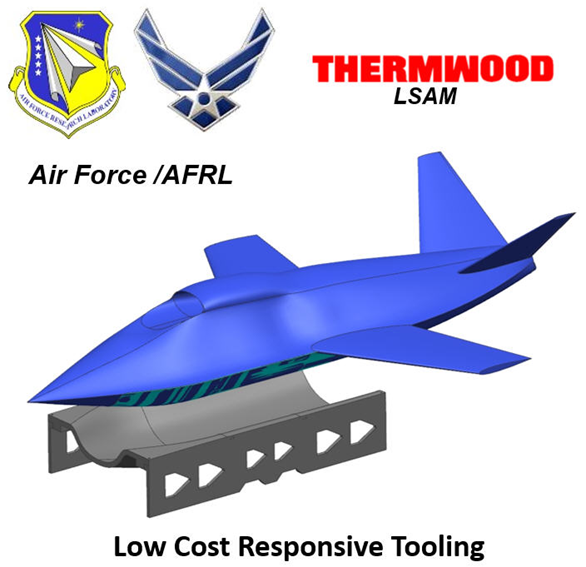
Figure 1: Air Force Research Laboratory Conceptual Aircraft & Full-Scale Tool
Please click below for video
The Thermwood LSAM machine offers an innovative additive manufacturing machine capability with its Vertical Layer Printing (VLP). The vertical layer printing AM process provides a significant cost benefit by increasing the size components can be printed, thus reducing assembly cost for large tools. To validate the VLP process using high temperature autoclave-capable materials, Boeing and AFRL chose to 3D print a section of the large tool to evaluate the LSAM functionality. The Mid-Scale tool was printed on Thermwood’s LSAM Additive Manufacturing Demonstration machine in Southern Indiana using a 40mm print core running 25% carbon fiber reinforced Polyethersulfone (PESU).
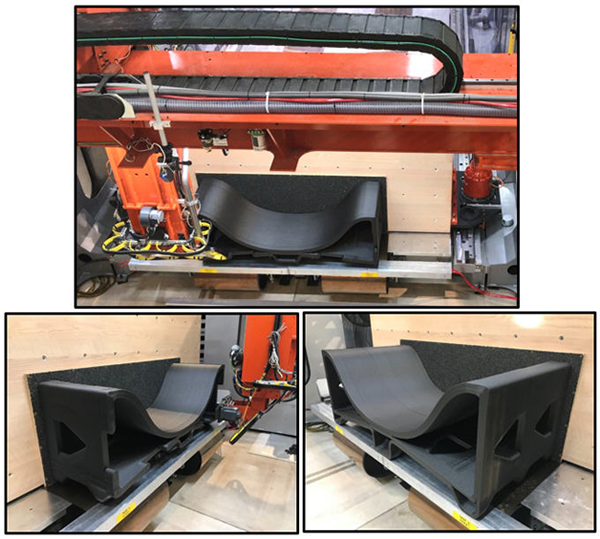
The initial test tool has the same width, height and bead path as the final mold, incorporates all major features of the final mold, but compressed in length being only 4 feet long. The final tool will be over 10 feet long. The Mid-Scale tool set a milestone achievement as the first high temperature tool printed using the VLP system. The Mid-Scale tool required 5 hours, 15 minutes to print with a print weight of 367 lbs. After final machining, the tool was probed for surface profile and tested for vacuum integrity. The tool passed room temperature vacuum test and achieved dimensional surface profile tolerances. The Full-Scale tool will weigh approximately 1400 pounds and require 18 hours to print.
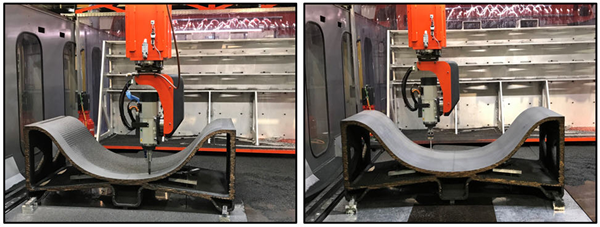 Figure 3: Machining (left) and Probe (right) operation on a Thermwood LSAM
Figure 3: Machining (left) and Probe (right) operation on a Thermwood LSAM
The program is progressing to the next step, producing a full size tool. Boeing and the Air Force are carefully documenting all operational parameters of the project to transition the technology to production programs. Additive manufactured autoclave tooling offers significant advantages over traditional methods of producing these tools. 3D printed tooling is less expensive and can be fabricated in days or weeks rather than months.
AFRL is very interested in tooling approaches for the Low-Cost Attributable Technology (LCAAT) program which has a goal to break the cost growth curve and field new systems faster. AFRL Program Manager Andrea Helbach says, “We are interested in additively manufactured tooling’s ability to reduce the cost and time to procure autoclave capable tooling. Additionally, AM tooling supports changes in vehicle design with minimal non-recurring expenses.”
“Future fielded low cost, but capable UAV’s will need a responsive materials and manufacturing processes strategy” says Craig Neslen, LCAAT Initiative Manufacturing Lead. “Additive manufactured composite tooling is one of many technologies being evaluated to ensure the industrial base can handle future manufacturing surge requirements as well as accommodate periodic system tech refresh activities which could necessitate minor vehicle design changes at an acceptable cost.”
LSAM is based on exciting new technology developed from an entirely new direction.
LSAM is intended for industrial production. It is not a lab, evaluation or demonstration machine, but is instead a full-fledged industrial additive manufacturing system intended for the production of large scale components.
Thermwood has already applied for 19 separate patents on various aspects of this new technology (several have already been granted and more will be coming as development continues). LSAM is truly “state of the art” in this exciting new world of Large Scale Additive Manufacturing.

Posted by Duane Marrett on Tue, Oct 09, 2018
Tags: Thermwood, Announcements, aerospace, 3D printing, Additive, LSAM, 3D Print, Thermwood LSAM, Additive Manufacturing, Vertical Layer Printing, Boeing, VLP, 777x
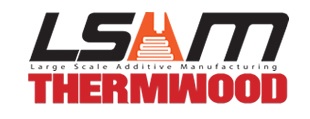
Boeing and Thermwood have employed additive manufacturing technology to produce a large, single-piece tool for the 777X program. The project is demonstrating that additive manufacturing is ready to produce production quality tooling for the aerospace industry.
Thermwood used a Large Scale Additive Manufacturing (LSAM) machine and newly developed Vertical Layer Print (VLP) 3D printing technology to fabricate the tool as a one-piece print, eliminating the additional cost and schedule required for assembly of multiple 3D printed tooling components. In the joint demonstration program, Thermwood printed and trimmed the 12-foot-long R&D tool at its southern Indiana demonstration lab and delivered it to Boeing in August 2018.
Boeing Research & Technology engineer Michael Matlack believes the use of Thermwood’s additive manufacturing technology in this application provided a significant advantage, saving weeks of time and enabling delivery of the tool before traditional tooling could be fabricated.
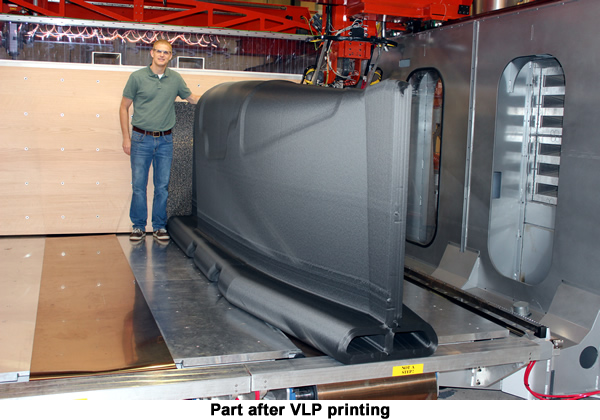
The tool was printed as a single piece from 20% carbon fiber reinforced ABS using the Vertical Layer Print system. Boeing purchased a Thermwood LSAM machine with the VLP functionality for the Interiors Responsibility Center (IRC) facility in Everett, Washington.
The ability to quickly produce large-scale tooling at a quality level suitable for a real world production environment represents a significant step in moving additive technology from the laboratory to the factory floor.
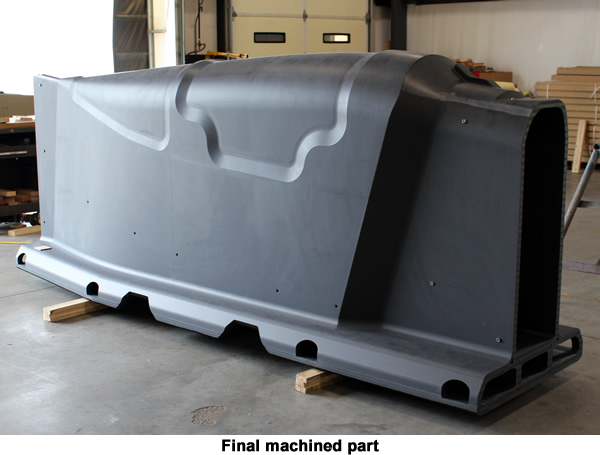
LSAM is based on exciting new technology developed from an entirely new direction.
LSAM is intended for industrial production. It is not a lab, evaluation or demonstration machine, but is instead a full-fledged industrial additive manufacturing system intended for the production of large scale components.
Thermwood has already applied for 19 separate patents on various aspects of this new technology (several have already been granted and more will be coming as development continues). LSAM is truly “state of the art” in this exciting new world of Large Scale Additive Manufacturing.
The Secret to LSAM Print Quality...A Different Process

© Thermwood Corporation. All Rights Reserved